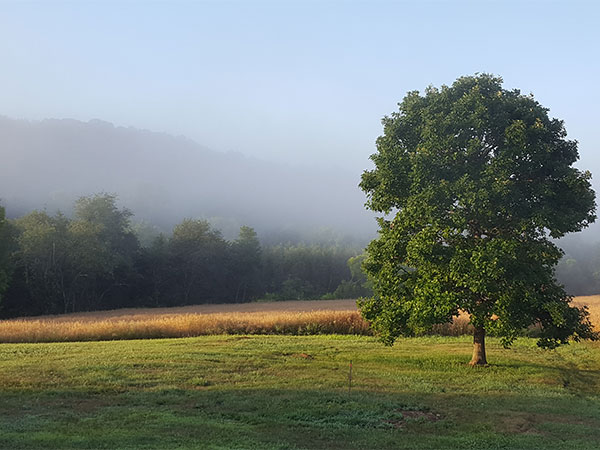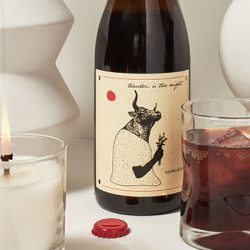

In 2014, when Kevin Pike and Robin Touchet bought the 18th-century Hudson Valley farm they hoped to turn into a grain-to-glass distillery, Pike took one look at the swamp behind the old cow barn and thought, “I better drain that.” But the swamp, he would learn, was actually wetlands, a crucial part of the local ecosystem and a habitat for frogs, snapping turtles, great blue herons and a family of beavers.
“My original instinct was to get as much tillable land as possible,” he says. “That was the wrong thinking. Instead of thinking about what the land needs, I was thinking about what I need.”
Pike and Touchet were new to farming, which meant they were open to new ideas—or new ideas based on very old ideas. As their Branchwater Farms evolved, the couple were drawn to regenerative farming principles as a way to improve plant health without using commercial fertilizers. They planted cover crops, like clover, which adds nitrogen to the soil while shading out weeds, and decided to refrain from tilling. Mycorrhizal fungi, found in the top 12 inches of healthy soil, have been discovered to promote an exchange of nutrients between plants and soil. Keeping the fungi intact allows the rich diversity of soil’s organic matter to thrive.
The couple grows corn and rye, as well as the wheat they use to make Branchwater Gin. In summer their fields look wild, with buckwheat, another cover crop, and milkweed attracting butterflies and other pollinators. Apple and pear orchards for brandy will come next. Touchet plans to graze a flock of ducks in the orchards, hoping they will gobble pests; their manure can be used immediately as opposed to nitrogen-rich chicken poop, which must be composted first.
“We’re trying to grow the soil into a living thing,” says Pike, “as opposed to something that gets plowed, chopped up until it’s dead—then you have to start all over again.”
The idea of farming in harmony with nature appealed to Touchet and Pike, who see themselves as stewards of their land. But regenerative agriculture is more than just a feel-good way of raising crops. Designed to boost biodiversity both above ground and below, the principles of regenerative farming also offer a way to sequester carbon. The rotation of crops allows for an ongoing cycle of carbon capture through photosynthesis. Forgoing tilling keeps carbon stored in the soil rather than releasing it into the atmosphere. Of course, Branchwater Farms’ biggest carbon sink is its 75 acres of mostly wooded land; only 25 acres are in fields. Pike and Touchet hope to enlist their neighbors to pool 500 acres in a land trust, protecting it from development even after they’re gone.
In the opening pages of her new book, A Good Drink: In Pursuit of Sustainable Spirits, Shanna Farrell asks “what the disrupted climate [means] for the future of alcohol.” An interviewer with UC Berkeley’s Oral History Center, Farrell has been researching how distilleries are responding to climate change, and agriculture certainly plays a part in her findings. But Farrell’s biggest concern—the focus of her interdisciplinary graduate work in environmental studies—is water. Distilleries use vast amounts of it and produce an estimated 12 times more wastewater than alcohol, according to a study published last year.
“[Distilling] is just such a water-intensive practice and nobody really knows how much they’re using,” Farrell says. “Especially if you’re using municipal water.”
In A Good Drink, Farrell describes the impact of yellow dent corn in American whiskey production. The ubiquitous, high-yielding variety is typically farmed using pesticides that can seep into groundwater. She travels to Mexico, where droughts have impacted dry-farmed agave necessary to tequila and mezcal production. Increased demand for water-intensive crops destined for export, like avocados, has led to a shrinking supply of groundwater available to agave farmers. Sugarcane, used to make rum, Farrell learns, may have the largest footprint of any commodity crop, requiring about nine gallons of water per teaspoon of refined sugar produced. What’s more, clear-cutting forests to plant cane is rampant, resulting in less vegetation to buffer runoff after storms and polluting waterways.
Farrell recalls working on the book in late 2018 while the smoke hung in the air from the Camp Fire, which destroyed the northern California town of Paradise more than 150 miles away. But the book doesn’t read as a doomsday prophecy. Rather, it offers glimpses into positive actions producers are taking to reduce their climate impact, from supporting sustainable farming practices to repurposing waste. Farrell bears witness to the shift in thinking among a new generation of distillers, who are more inclined to view spirits as agricultural products than their predecessors may have been and are taking farming’s environmental consequences into consideration.
“I’m hopeful that people will start paying serious attention to [these issues], treating them as urgent needs,” says Farrell.


A number of distilleries, like businesses in other industries, are making climate pledges. Diageo, the world’s second-largest spirits producer, will open a new carbon-neutral distillery in Kentucky by October as part of its goal of sourcing all of its electricity from renewable sources by 2030—a complicated undertaking for a large multinational firm. The smaller Appalachian Gap Distillery, in Vermont, outfitted its facility with solar arrays before seeking third-party help to further reduce emissions. Their choice, Climate Neutral, is a non-profit that offers carbon-neutral certification at a far lower cost than hiring a private climate consultant.
“I was researching other beer, wine or spirits brands to see whether any had taken a similar step. And Climate Neutral kept popping up,” says Will Drucker, who heads up sales and marketing for Appalachian Gap. He liked that the organization offered a label that customers could easily recognize.
Climate Neutral is only two years old, but has already certified such brands as Allbirds shoes and East Fork pottery, as well as a handful of wineries and breweries. It provides companies with a toolkit to measure emissions, then helps them devise a plan to offset them through carbon credits and reduce them over time. The organization worked with Appalachian Gap to account for every aspect of its carbon footprint—from the distillery’s energy usage to kilograms of grain purchased to business-trip air miles—and plugged the information into its carbon calculator tool, which runs on data from the Environmental Protection Agency and the United Nations’ Intergovernmental Panel on Climate Change. Following several carbon-accounting frameworks, including the Greenhouse Gas Protocol, Climate Neutral requires companies to account for emissions generated up until the moment their product is in the customer’s hands.
“I think people, when they think about their own carbon footprint, they focus on the times they fly or the miles they drive. And all of that is completely true,” says Drucker. But the carbon-neutrality certification process forced him to think about the ripple effects of the distillery’s operations, including emissions associated with manufacturing and transporting glass bottles, corks, labels, grain, cleaning equipment, even a new forklift.
“Once you start thinking about all these things and their respective impacts, it can get quite big quite quickly.”
A problem as big as climate change, he concluded, in the absence of a big solution, would require a multitude of small ones.
Chantal Martineau is the author of How the Gringos Stole Tequila and co-author of Finding Mezcal. She lives in New York's Hudson Valley.
This story appears in the print issue of October 2021.
Like what you read? Subscribe today.


















